|
|
|
|
Contact:
|
DIY Windscreen/Potstand - Old School
Cone Shaped Windscreen-Potstands
Charcoal Starters - related ideas
|
Here are just a few methods of making a potstand for your stove and pot. Please view our PotStand Parent Page for an intro of other options.
Cone Stands (aka Frustum Potstand, Frusto-Conical, Frustoconical, Tapered Tubular, Bell Shaped, Truncated, Inturned)
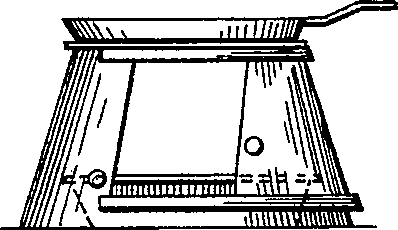
1897 US Patent 605,571
19th Century Cone shaped potstand with pan and alcohol stove
This has an access door which allows you the ability to adjust the amount of air flow into and out of your potstand
Conical, bowl and bell shaped pot stands (furnaces, firepots, cooking utensils) have been around for a very very long time. They have been used in times of old to concentrate heat around a pot or grill for cooking and are still commonly used in kitchens around the world to support round bottom woks and pots.
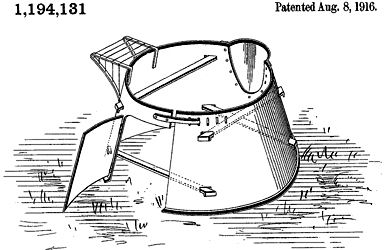
1916 US Patent 1,194,131
Note how side ends are joined to allow for changing the size of the cone or opening it up
You can open up the potstand to some extent while boiling water to add or adjust fuel
This can also be rolled up for storage per the patent description
This type of pot stand is generally more difficult to pack and build than other potstand designs, but when built properly, it can provide a sturdy base while trapping heat around the bottom and sides of your pot. This is particularly useful for tall narrow pots - such as can pots, which have only a minimal bottom surface area and allow for packing of taller rolled up windscreen/potstands.
Supporting Pot with Cone Shaped Potstand
Most of the same pot support techniques used for cylinder shaped potstands mentioned on our Windscreen/PotStand Combo Page can be used for cone shaped potstands. And since cone shaped potstands are often used to maximize heating of pot sidewalls, cone shaped potstand/windscreens are often set up to engage the pot higher up, such as around the pot's upper outer rim.
Here, you can see an early camp stove cook set designed so that the pots' specially designed outer rims (for pot and lid/pan) can rest directly on the upper edge of the cone shaped windscreen. This makes for a stable setup and maximizes heat transfer to the bottom and sides of its pots (lid doubles as shallow pot/pan). Related potstands: Optimus Trapper 81 and German Alfi

1939 US Patent 2,154,305
Note how the upper cone shaped windscreen directs heat from stove up the sides of the pot
Also see Swedish Army Jagerkok
If your pot lacks a specially made outer rim to adequately support it securely on a potstand, you still have many options. If you are using a pot with opposing handles, you can use these handles to support the pot on the potstand. See US Patent 1,710,971, 2,080,592, 3,593,647, 4,872,445.
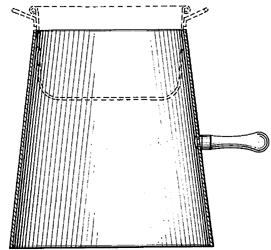
1937 US Patent 2,080,592
Pot supported by handles
Another option is to create a ridge or fold around the outer edge of your pot to allow for a safe and stable means for your pot to engage your pot stand.
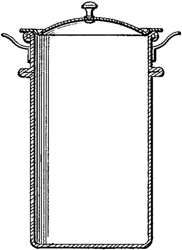
1916 US Patent 1,202,212
Note the ridge just below the handles of this kettle.
This was designed specifically to rest within a potstand to maximized heat around the pot's side.
Related Patents: 33,909, 485,819, 878,908, 1,290,168, 1,468,841, 1,496,430, 2,640,478, 3,371,819, 4,368,727 and 4,397,298
Creating a circumferential rim around your pot can be much easier to accomplish then you may think (YouTube yclKeJ2E1qc), at least with pots made from beverage cans. Here is an example of a commercially modified beer can.
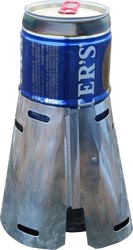
Beer Can with rolled ridge
This appears to be a Trail Designs Caldera Cone
Silicone-rubber bands wrapped around cans and pots have worked surprisingly well to support pots on a cone shaped potstands. See here and here. This may be particularly useful for very narrow pots and can-pots.
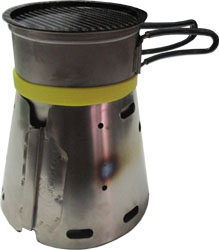
Silicone-rubber band supporting mug
I believe that this is a Caldera Cone potstand adapted for use without tent stake supports
If a silicone-rubber band works, Sugru may also be used to form a similar support and area to grab the pot with.
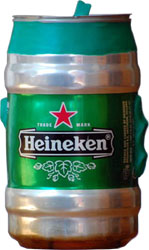
Instructables lip guard and grab area made with Sugru
Sugru or high temp Epoxy can be used to make supports for potstand
Fiberglass wick (potentially itchy) or Kevlar cord (not itchy) can be wrapped around a stove to act as a base for a potstand as well as for something to grab on to when the pot is hot. Good cord wrapping, knot tying technique, sewing with Kevlar thread and/or high temperature epoxy or RTV sealant can help secure this in place. Examples and discussion can be found at backpackinglight.com 10468.
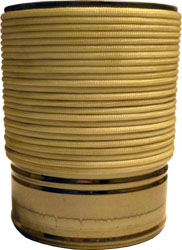
Soup Can Mug with wrap
If single wrap isn't enough to stabilize your pot on your stand add a second layer
You can also braid your cord/wick for nice results
Melting or Failure Points
| Material |
°C |
°F |
Notes |
| Graphite Felt | 2000°C | 4500°F | |
| Silica Seals | 1260°C | 2300°F | Seals for ovens |
| Carbon Felt | 1200°C | 2192°F | |
| Asbestos | 1200+°C | 2192+°F | Cancer |
| Fiberglass | 1200°C | 2192°F | softens and degrades |
| Wool | 600°C | 1112ºF | Ignition temp |
| Kevlar | 500°C | 932°F | Doesn't melt - Degrades |
| Technora | 500°C | 932°F | Fancy Kevlar/Tech Cord |
| Vectran | 330°C | 626ºF | |
| Baking Silicone Mat | 316°C | 600°F | |
| JB Weld Epoxy | 316°C | 600°F | 10 minute exposure limits |
| Polyester | 250-300°C | 480-580°F | |
| Nylon | 190-350°C | 374-663°F | |
| Cotton | 150˚C | 300 ºF | Decomposes; Easily burns at 255˚C |
| Sisal | 150˚C | 300 ºF | |
| Manila | 150˚C | 300 ºF | |
| Spectra | 147°C | 297°F | |
| Super Glue | 82°C | 180°F | Slightly better for Hi temp super glue |
See our Wick Stoves Page for More on Wicks
It is also possible to use Fiberglass Drywall Tape, Fiberglass Muffler Tape, Medical Fiberglass Cast Gauze, Fiberglass Cloth (auto body and other applications), etc. to make something similar. A 100% wool sock or fire blanket may even do the trick. Weaved Kevlar cloth or tape can also be sewn together with Kevlar thread to make a really nice grab area and support edge. Other fabrics can be made fireproof through chemical treatment (See wikihow Make-Cloth-Fireproof). High-temperature silicone tubing may also work.
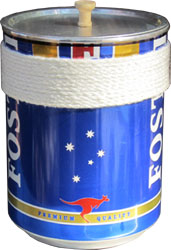
Fiberglass wick or Kevlar cord can be used to support pot on windscreen
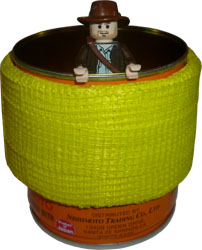
Recycled steel can "mug" with fiberglass drywall tape wrap
The fiberglass tape doubles as a handhold and an area to rest on a potstand
Aesthetics will vary greatly depending on how you hide the tape's edges
Spot welding, brazing, epoxying or otherwise securing on two tabs or nubs (US Patent 474,619, 574,492, 1,609,114, 3,838,680, 4,532,911, 4,688,549, 4,784,112, 5,048,506) horizontal to the pot's handle will allow for a similar but more durable and heat resistant means for supporting your pot on a cone shaped potstand. Stainless or Ti bolts can be placed around upper rim so that they protruded a bit for placement on the potstand (US Patent 1,609,114) - two+ can be used alone or one+ can be used in conjunction with the pot handle in a specially fitted potstand.
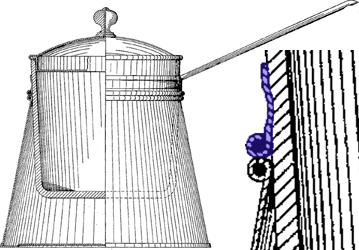
1885 US Patent 318,365
Here a band with a rolled bead is soldered to the side of the pot.
A similar support ring to the one shown above can be made with aluminum sheet from the side of a beverage can. Simply cut out a long strip, roll one side over a thin metal rod, bend around your pot and then pull out the rod. The overlapping roll can be squeezed into the other end for an aesthetic and stronger joint. This strip/ring can be epoxied or otherwise attached to the side of your pot.
A Baking Silicone Mat is rated to 600 degrees F and is dishwasher safe. You may be able to fashion something out of this.
A more durable and easier solution is to open a steel can (e.g. soup or coffee can) with a traditional can opener then cut and keep the top one cm or so from the top of the can. Deburr, smooth, trim and attach this ring so that the rim faces downwards. This can be epoxied, attached with high temp RTV gasket sealer, bolted tight, spot welded, compressed with cord/wick or otherwise attached to your pot. This can be a particularly good setup for a CanPot made from a recycled steel can if you are looking for something very low cost, low weight and functional. Due to the low profile of the attachment, you will need a very tight and properly sized potstand. If you are not satisfied with the security of this setup, you can cut out the bottom of a metal can larger than your pot and use a drafting compass to score a properly sized opening for your pot. Adjust as necessary and smooth off all edges. Slide you enchased ring over the bottom of your pot and you're done.
Metal wire and a few beads, sections of metal tubing or other items can be strapped to the side of your pot for a very simple pot stabilizer.
You can take a strip of thin sheet metal and place 3 pot rivets through it. The third rivet can be used to turn this strip into a ring with the long ends of the rivets facing outwards. Done right, this can slide tightly over the pot with a "press fit". The three protruding rivets will allow the pot to sit directly on a tight or somewhat loose fitting conical or cylindrical potstand. Bots and other fasteners can be used in lieu of rivets.
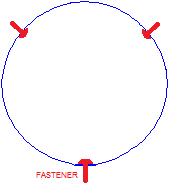
Three strips of sheet metal can be joined together with with fasteners or rivets to create a ring with three protruding points of fixation.
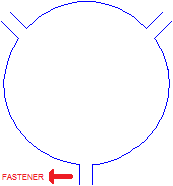
Three strips of metal joined with fasteners or folds to form ring around pot
Ensure you round off all corners to prevent cuts to body or gear
A pot with a tapered (Sierra Cup) or rounded (bowl or wok) bottom can fit nicely cradled in a the top opening of a cone shaped potstand by its sidewall. This is a common configuration for hot plate meals in Asia and was a popular potstand (portable furnace) configuration in the past. See Publication US 2004/0200359 A1 and US Patent 40,570, 179,623, 875,216, 924,162, 1,290,168, 1,353,265 and 4,909,235.
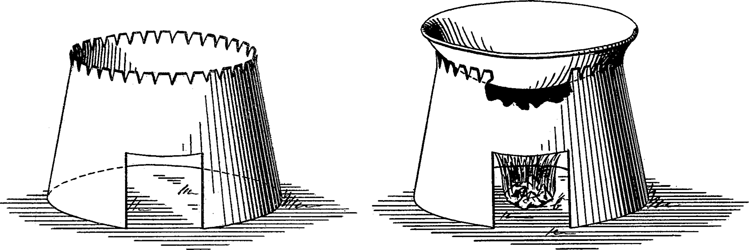
1876 US Patent 179,623
Here we see the upper opening of this potstand easily supports a pan with a rounded bottom
This setup is designed for use with wood, gas or a spirit lamp
Also see Publication US 2004/0200359 A1

US Patent 875,216
The furnace show above was later improved with multiple vent holes and an access door
Exhaust ventilation in the in this design was out the back with a chimney
A pot can also be secured by the outer rim found on most stoves. This has been used by many potstand designs in the past and is popular for multiple reasons. For one, it can allow for secure support of the pot with the center of gravity of the pot below the mounting point of the pot on the potstand. This make it a more difficult to knock over a pot. Allowing a potstand/windscreen combo to come all the way up the sides of the pot allows you to protect the sides of the pot from wind and more importantly - funnel heat and flames from your stove around the sides of the pot to minimize wasted heat from your stove. This has been used in various configurations in older camp cook sets and hotplates in Asia.
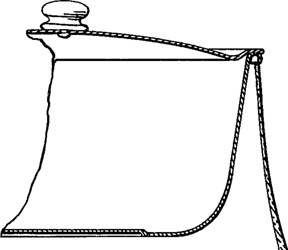
US Patent 2,282,400
Rolled pot rim resting on upper edge of cone shaped potstand
Also see US Patent 2,076,437, 2,154,305 and 3,809,063, 5,797,386 and US 2004/0200359 A1
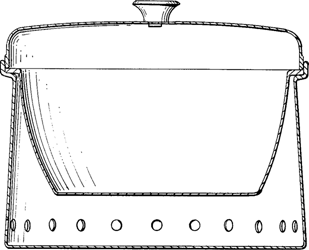
US Patent 3,809,063
Supporting the pot by it's outer rim on the top edge of a cone shaped windscreen is currently a very common pot/potstand configuration for backpackers now that Trail Designs offers a line of potstands for a wide range of popular pots. Kudos go to Rand Lindsly of Trail Designs for taking the cone windscreen idea and developing ways to make these "Caldera Cones" readily available for the backpacking community. And beyond their regular line-up of potstands, they may also be willing to custom make you a potstand for a special pot or special use (e.g. two part for storage, wood burning, etc) if you ask.

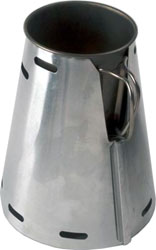
US Patent 7,967,003
Trail Designs Caldera Cone
Note Magnet closure and access for pot griper or handle in patent illustration
Also see US Patent Application 2009/0314274
Others have since improved upon his designs and have made it easy for DIYers to make a wide assortment of working potstands for various applications. Many of the DIY versions of Windscreen-Potstands which rely on supporting the pot by its upper rim are quite sophisticated and elegant. Please review the Conical Shaped Pot Stand Patents section below prior to your own DIY project.
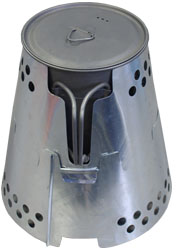
Captain Paranoia Two Part Potstand
See Application 2007/0039603 A1 and 2009/0314274 and US Patent 118,095 and 7,967,003 B2

Dual Cone Stove Stand
Note interlocked upper and lower cone sections
Inner inverted cone allows for increased focus airflow over pot sides
Handle rest directly on stand for additional support
Single large lower air aperture can be closed off with a piece of aluminum or a door can be adapted to stand
With proper ventilation, the pot's bottom can just sit directly on an appropriately sized potstand itself. This is particularly useful for pots with a side that tappers down (such as the Sierra Cup) or for pots with rounded bottoms such as woks. This has been used by many stove designs in the past. Reference US Patents 754,582, 4,026,265, 4,604,986, 7,107,983.
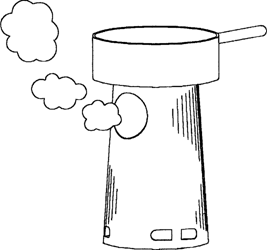
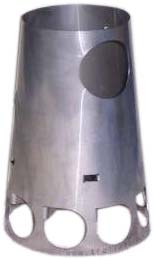
US Patent 65,2073
Stratus TrailStove
Tabs can be welded, riveted on and otherwise attached to the inside or outside of the stove to provide a more stable platform for your pot. US Patent 600,398
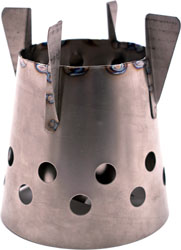
Bushcooker
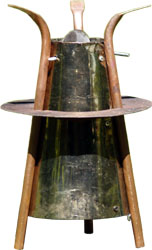
Much like the popular cylindrical windscreen/potstand Pot Support ideas such as using lateral metal rods can be used to hold up your pot. Holes at various levels can allow for adjustment of pot height for different pots or different stoves, such as when you switch between hexamine and alcohol. See US Patent 179,6232 (grate bars) and 1,131,226.

1916 US Patent 1,194,131
Horizontal support bars can lock in place to safely support pot
You can even open up this potstand to some extent while boiling water so that you can add fuel or adjust logs
If you make your screen out of steel (stainless preferred) or titanium, you can create a potstand that doubles as a wood/biomass stove. Note how the commercial Titanium Goat stand below allows for use of tent stakes to hold the pot up high and allow enough room inside the pot stand for a protected wood fire, and if the stakes are removed, the pot can sit much lower with the top of the stand snuggly wrapped around the underside of the pot's outer rim for use with an alcohol stove.
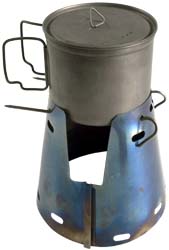
Titanium Goat Pot Stand in Wood Stove configuration
Rand Lindsly points out that this potstand is actually made by Trail Designs for Titanium Goat and is Lindsly's design
Metal rods can also be used above or through your pot. You can wrap heat resistant string around your pot with loops for a rod, use wire to do the same or create another type of attachment point for a rod or even a metal spoon. You can also just drill through your pot and run a rod straight through it. These attachment points for your rod can also be used as a hanger for other applications and/or as a wire bail.
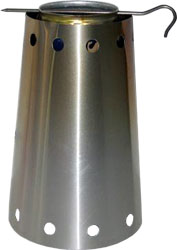


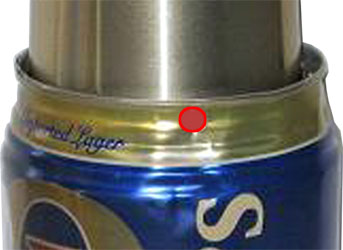
Tent Stake through top of CanPot
Hole in thin aluminum can be made with a simple hole punch
Riveted, bolted or hanging supports and/or any number of other tricks may be used to securely hold up your pot. And depending on configuration, you may be able to use a various assortment of pots with the same potstand.
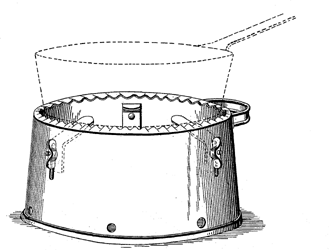
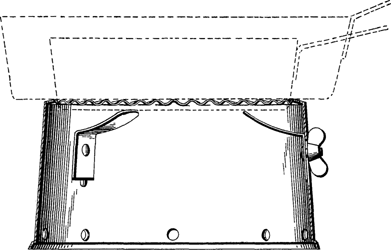
US Patent 690,760
Note removable supports attached with wing nuts
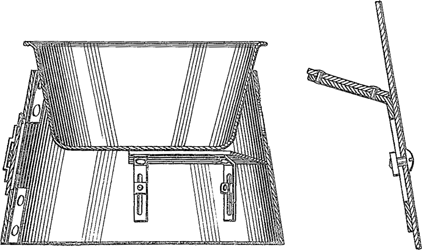
US Patent 875,216
Here we have L brackets which can be adjusted up and down
Yet, another technique is to use pot collars (aka stove rings). A pot will fit snuggly into a properly size collar and the collar is placed on the potstand. This allows of a single sized potstand for multiple pots. It also allows for more space around the top of the pot for heated air. This technique is mentioned in the US Patent 118,095, 862,719, 1,022,237, 1,071,151, 2,080,592 and 4,337,752. Also look at the Trangia Stormkjøkken flip supports, Alpkit and Meta 50 - Schweizer Feststoff Tabletten Kocher riveted supports which can hold a fry pan over the windscreen or support a pot by its upper rim with pot recessed in windscreen.
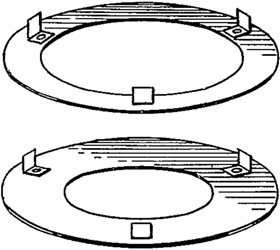
1907 US Patent 862,719
Collars allow for different sized pots to fit in same potstand/windscreen.
Captain Paranoia has developed a Strata adapter which allows you to fit smaller pots within a larger cone shaped windscreen. He also has a Post Script file below which can produce printable templates for such an adapter.
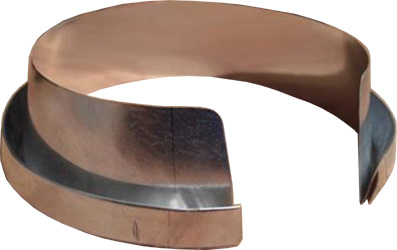
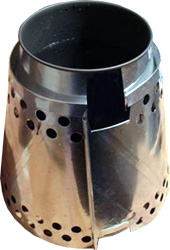
Captain Paranoia Strata Adapter
See also outdoorsmagic.com 22357
Folded ridges can be used in a number of configurations. The template example shown below creates a folded potstand similar to the "StoveStomper" folded windscreen shown above. The top half is optional if you desire a very tall windscreen which covers the entire potstand and a flat "Flissure" (see below) top section can be created to allow of easier storage. The folded in ends can be joint together permanently (rivets, bolts, folds) or temporarily with hairpins, paper clips or binder clips. Storage of this type of potstand can be a little tricky as the folded in tabs can section off some of your pot. This design is better suited for wide pots than narrow ones.
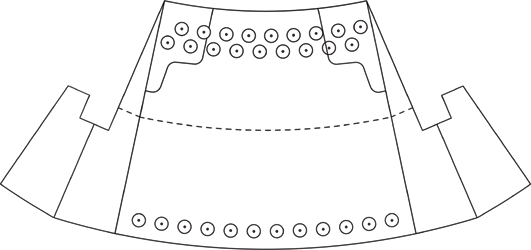
This 1/3 section of a conical post support has supports made from folds
These folded tabs can be joined with two 1/3 other sections by a number of means to create a complete cone
The support tabs can be trimmed or reinforced by a number of means
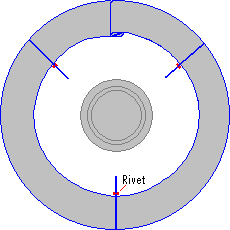 |
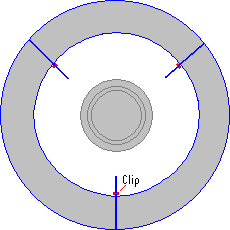 |
| Continues windscreen | Sectional Windscreen with clipped tabs |
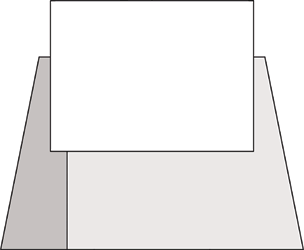
Here is an illustration of a windscreen-potstand (light gray) with 1 of 3 folded in tabs (dark gray) supporting a pot (white)
The top of stand is trimmed off before hitting side of pot to allow for unobstructed upward flow of exhaust gasses
Ridges can also be created from simple folds. These can be used to add ventilation and/or to be used to to support a pot by it bottom, sides or rim. Something similar is mentioned in Rand Lindsly's US Patent application 2007/0039603 A1.
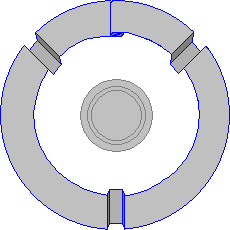
Folded ridges used to support pot
The following bottle holder should spark a few ideas on how to support your pot in a cone shaped pot stand. Metal supports can also be attached in a number of ways to the cone shaped support.
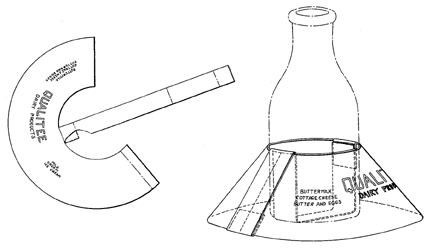
US Patent 2,063,328
Here is an example of a cone shaped potstand secured to the side of a pot with a compression ring.
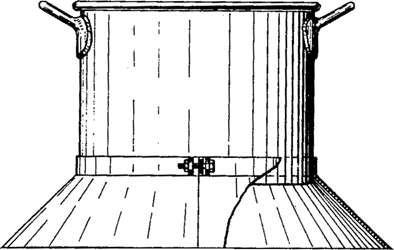
US Patent 162258787
Note how potstand is attached to side of pot
Metal sheets can be boxed into various shapes, including cone shapes. These can be used a wood stoves when made from steel or titanium, and can also double as multi fuel stoves depending on how you configure them. Many of the techniques above can be used with these boxed designs. Also see US Patent 1,062,304 (pentagon shaped).
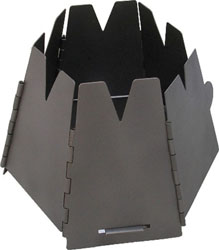
Vargo 4.1oz Titanium Hexagon Backpacking Wood Stove
Also see Suluk Collapsible Titanium Wood Stove
Many pails and buckets have been used as upright or inverted potstands and stoves for various fuels. See sailfar.net 8658
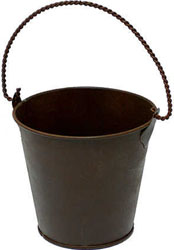
Tin Pail
Cutter has a line of Citro guard candles which come in a small cone shaped canister. With ventilation added to the bottom (if you opt to not use it as a candle stove), you have a ready made potstand for your pot. For a mug, you may need to get creative, like splitting the cone vertically so that it rolls up for storage and possibly running rods through it for bottom supports.
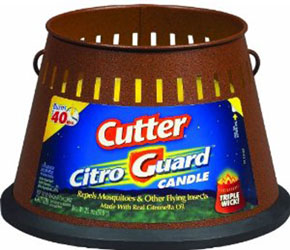
Cone shaped windscreen materials can be found in many hardware stores already made. Besides shaping sheet metal, you can use tapered reducers used for HVAC ducting and storm collars. These can be found in both aluminum and steel. Venting can be added to make an efficient windproof potstand prototype. Steel ones can be used as wood burners. Patent 1,592,729 describes a tapered windshield which looks very similar to a tapered reducer.
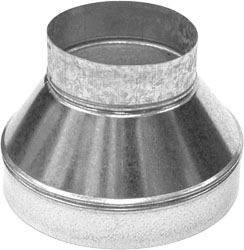
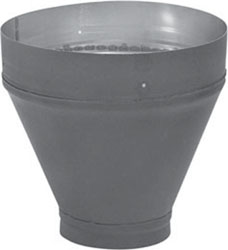
Tapered HVAC Reducer and Increasers
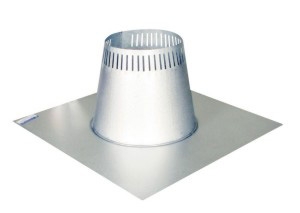
Storm Collar
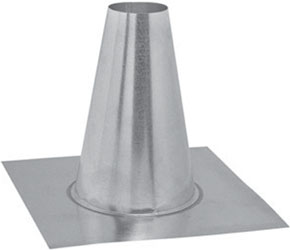
Tall Cone Flashing
A cone shaped windscreen/potstand can be made by crimping a spherical potstand and then closing the diameter of one end to create a conical taper.
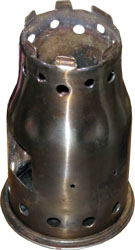
Certain cone shaped Thermos containers can be modified into cone shaped potstands and stoves. These are sometimes referred to as FireMugs. See bplite.com 4684.
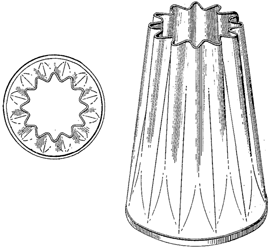
US Patent 1,377,807
Truncated Hollow Conical Member
Also see US Patent 172,857 and 1,592,729
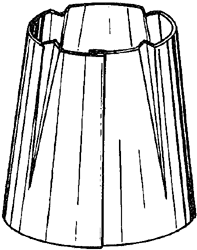
US Patent 4,311,130
Similar focusing of stove heat around the sides of a pot can be achieved with crimping of the top of a windscreen wider than the pot.

US Patent 690,760
Crimped to allows for space around sides of pot, while still trapping heat around the pot.
Folded tabs on the top of a windscreen will also have a similar effect. This is mentioned in US Patent application 2007/0039603 A1. It is also used by the Flat Cat Snow Leopard system. Also see 179,623, 3,339,505 and 5,404,864
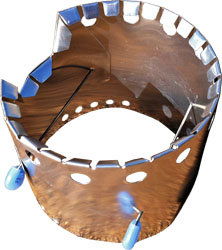
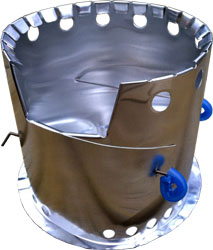
Flat Cat Snow Leopard
For future reference: 4,589,619
Storing a Cone Shaped Windscreen
This can be a challenge as a conical windscreen roles up longer than a comparably sized tubular windscreen. And if you are maximizing on the cone shaped windscreen design by directing heat from your stove around the sides of a pot, you will want a windscreen that goes up to the top of your pot - making for an even longer windscreen when rolled up. But if you want to store your windscreen in your pot, you may be forced to compromise and use a shorter windscreen. However, if you are creative, you can take one of several approaches at storing a full size cone windscreen in a way that it's protected from the contents of your pack.
Some hikers fold their windscreens for easy storage. Folding has long been the practice for storing less sophisticated and less expensive commercial and DIY windscreens in the past. Folds in what was originally a smooth cone shaped windscreen can look very unappealing, but reportedly still works.
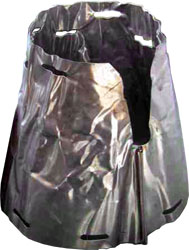
Folded windscreen is less than aesthetically appealing, but seems to be functional
Many hikers around the world have created split cone windscreens which stacks one over the other. This allows you to more easily store your windscreen within your pot with minimal use of space. Trail Designs has/had something called the Fissure. See backpackinglight.com 57714, backpackinglight.com 256909, livefortheoutdoors.com 204944, US Patent Applications 2007/0039603 A1 and 2009/0314274 and US Patent 7,967,003 B2.
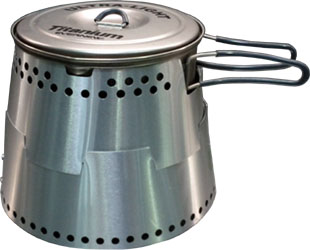
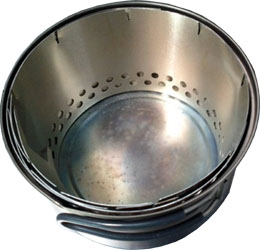
Here is a wonderful two part "Flissure" stacking Cone potstand which fits easily in a pot it supports when disassembled
This potstand was built largely by use of Captain Paranoia's PS script below
Its just a matter of time before these become commercially available
If you are able to make a conical potstand that can fit in you pot, you may also be able to fit it in a loose fitting pot cozy with the screen wrapped around your pot. This may keep some soot and possible fuel particles out of your pot if that is a concern. See backpackinglight.com 397141
Some wider and shorter pots will allow you to place your windscreen rolled up sideways. This allows for a single piece windscreen, but will take up the majority of storage space in your pot.
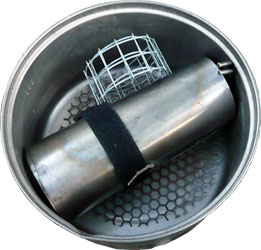
adventuresinstoving.blogspot.com
Trail Designs Sidewinder
Many have used various plastic cylinders to protect their rolled up windscreens. You can find all manner of suitable plastic containers in the grocery store. Some use a cut down plastic bottle (such as a Gatorade bottle) to protect one end of their rolled up windscreen and their mug or narrow pot to protect the other end. A cut down bottle can also double as a bowl or mug.
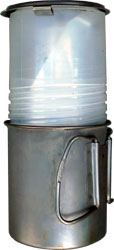
Rolled up windscreen in plastic tube in mug
Another option used by many hikers with tall windscreens, or for those who don't like to store their stoves and windscreens in the pot they are cooking out of is to roll their windscreen up with your sleeping pad. See Howard's Esbit Stove.
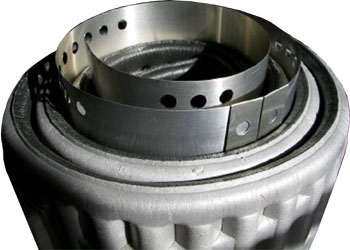
Rolled up windscreen in sleep pad
A tight fitting cone shaped windscreen can do a great job of focusing heat around the bottom and sides of a pot, but you will need to allow exhaust gasses to exit your potstand to allow your stove to operate properly. And for many setups, this means allowing exhaust gasses to exit as high and as close to your pot as possible to allow for continued combustion up the sides of a pot. There are several methods which can be used to prevent the top of a conical shaped pot stand from choking off your stove.
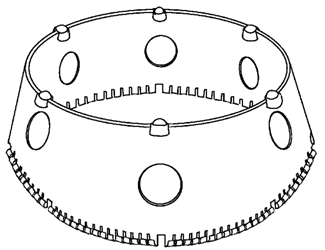
US Patent 7,694,671
Note how nubs at top of potstand allow fitment a round wok while still allowing for exhaust gases to exit around a wok's bottom
 |
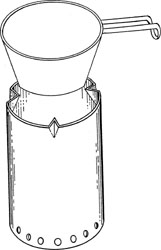 |
|
US Patent 4,311,130 |
US Patent 4,905,659 |
Folded in ridges can help grab a pot while allowing for evacuation of hot gasses
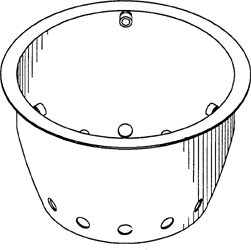
US Patent 5,303,691
This design uses riveted spacers to maintain space for ventilation
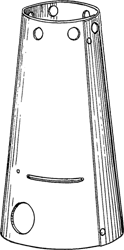 |
| 1977 US Patent 4,026,265
This design allowed for a grill to be attached over the stove for grilling For use of pot and pans, the upper openings allow for gaseous fumes to escape Also see 4,321,907, 2009/0314274 US 7,967,003 B2 and Swedish Army Jagerkok |
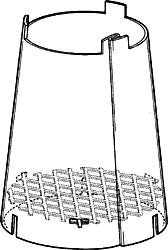
US Patent 7,107,983
Upper tabs allow you to trim away a little metal
Also see D250931 1,353,265 2,282,400
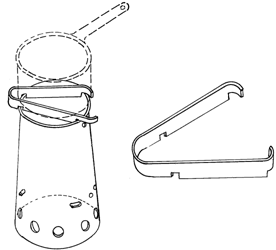
US Patent 4,282,854
A horizontal spacer across the top of the cone should work well
This one also serves as a bucket handle
Also see 3,903,866

US Patent 179,623
Notches cut in the rim mat weaken a cone shaped potstand depending on gauge of material
Also see Cone Shaped Stove and US Patent 1,072,115
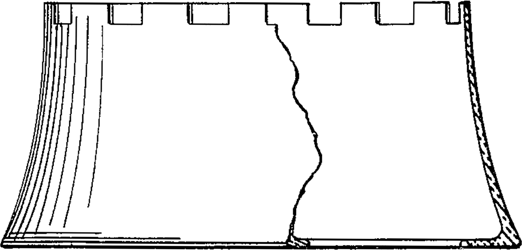
US Patent 2,282,400
Similar upper notched idea designed to support pan by rim
Also see 179,623
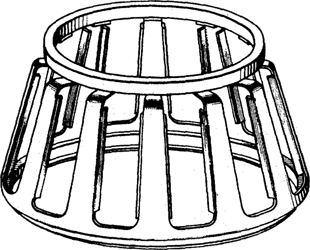
US Patent 3,391,687
Having open sides allows for great ventilation but at the cost of lost wind protecting and heat retention
Also see US Patent 673,965 and 8,028,690


US Patent 690,760
Crimping can allow for ventilation of a pot within the crimped section or above it
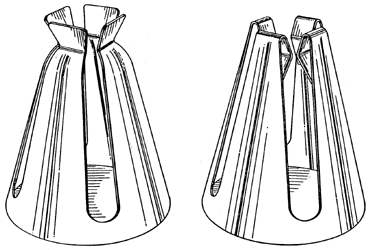
US Patent D318393
Folded in or riveted/bolted tabs can space out a pot while securing it
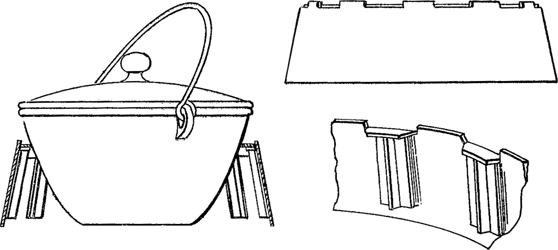
US Patent 1,353,265
Note inward facing ribs
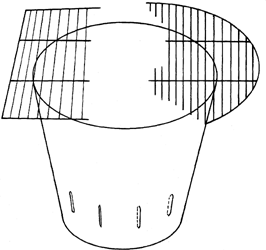
US Patent 5,682,872
A grill, mesh or expanded sheet can be used as a platform
A hole can be cut out to allow a pot to drop in and be supported by the mesh
Also see US Patent 989,417, 1,239,150 and 2,555,779
Also see backpackinglight.com 38016
You can also just build the top part of your cone wide enough so that it fits a little loosely and use metal rods or other means to support the weight of your pot.
A certain amount of carbon monoxide is created from any stove which burns a hydrocarbon fuel. And certain factors will increase carbon monoxide production. Basically, anything which comes in contact with the flame will disrupt it and increase the amount of carbon monoxide produced. An idea shared by many stovers using a cone shaped windscreen is to create a tight windscreen which maximizes the amount of the flames and heat contacting the pot's surface, both pot bottom and side. This can in turn disrupt the flame and increase overall carbon monoxide emissions. This is particularly true with narrow pots and tight windscreens. See our Carbon Monoxide Hazard page for more information.
Conical Shaped Pot Stand Patents
US Patent Application 2009/0314274
There are many US patents which call for a conically shaped pot stand or windscreen. There are also many stove and potstand examples presented on and throughout this site which may also incorporate claims presented in both active and inactive patents in the US or worldwide. We are also aware that some of the newer patented designs may have been influenced or inspired by information presented on this site. C'est la vie.
Regardless of where ideas originated or if you came up with a design completely independently on your own, it may still be illegal to make, use, offer to sell, or sell certain pot stand configurations in the US without the expressed permission from the owners of any active US patents which you may happen to infringe.
According to US law, it is feasible for a patented item to be "made or used as an experiment, whether for the gratification of scientific tastes, or for curiosity, or for amusement". And if you are outside the US, it is likely that you are free to make whatever you like for your own personal use - you will of course need to check your local patent laws which apply to you.
If you find a patented design of interest and would like to work on a project without infringing on that patent, there are several steps you should take. You should seek out to find a copy of the granted patent in question as well as any related patent. Study the claims section thoroughly, keeping in mind that legalese is a language and culture in itself and that each and every word was selected for a reason. The claims section will spell out exactly what ideas the patent protects. To infringe on a patent, you must meet every aspect of a claim. If your idea doesn't meet every aspect of a claim, you don't infringe on that patent. If you do meet each and every aspect of a claim, you may need to reconsider your design and find an alternative variation which does not infringe on that patient's claim.
US Patent 7,107,983
Some recent and notable Conical Potstand Patents and Publications:
"Windscreen for Backpacking Stoves" 2007/0039603 A1 Application Only Trail Designs Caldera Cone
"Windscreen for Backpacking Stoves" US 7,967,003 B2 Trail Designs Caldera Cone
"Lightweight, portable cooking stove" 2009/0314274 Application Only Synergy EC ThermoJet
"Portable Solid Fuel Stove" US 6,520,173 Stratus TrailStove
"Portable Stove" US 7,107,983 Tipi Stove
Examples of possible non-patent infringement projects you can consider:
Building the Strata conical reducer adapter
Infernal Wood Stove
Conical wood stove which does not violate US Patent 6,520,173 or 7,107,983
A conical windscreen which does NOT double as a potstand
Inverted conical potstand (small side down)
Noncollapsible-windscreen/potstand of just about any design
Collapsible windscreen/potstand used to support a round bottom wok
Collapsible windscreen/potstand used to support tapered bottom of bowl or pot by its sides
Collapsible windscreen/potstand which supports pot by metal rods
Collapsible windscreen/potstand which supports pot by handle and one rod
Collapsible windscreen/potstand which supports pot by folded in vertical ridges or attached supports
Collapsible windscreen/potstand which supports pot by pot ridge (low, mid pot or even directly under pot rim) created by fiberglass wick, Kevlar cord, epoxied wire/tube, attached metal tabs, compression ring, etc.
Collapsible windscreen/potstand which supports pot by pot handle and one or more points on upper rim
Basically any collapsible windscreen/potstand where the pot is not suspended and supported solely by the lip on upper edge of your pot
Collapsible windscreen/potstand which supports pot by upper outer rim and only has a single lower ventilation opening
Any potstand design that was patented greater than 20 years ago
Any potstand design not used for burning fuel - such as for a solar stove, for displaying a pot, for holding a flower pot, etc.
Any potstand described in US Patent 7,967,003 B2 for use with solid fuel without a stove (e.g. wood, charcoal, newspaper, hexamine, trioxane, candle, solid alcohol, C4)
Any potstand design patented only in the US which is made and used anywhere other than the United States, U.S. territories, and U.S. possessions.
Any potstand design "made or used as an experiment, whether for the gratification of scientific tastes, or for curiosity, or for amusement"
Patent Infringement Free Conical PotStand
Stand not solely supported by rim
Handle holds half the pot's weight
High temp silicone tubing used on handle to protect hands and is notched to lock on potstand
Kevlar Cord around upper rim supports and secures upper stand wedges
No upper air apertures (debatable)
Only single lower air aperture present
Used without stove - Hexamine tablet on foil to protect ground
Experimental use only
Made and used outside of US
Note: Information shared above is believed to be accurate and provided in good faith. There may be other patents, pending or granted, or part of patents which I am not aware of and therefore have not considered. If you have any information related to this subject, please send me an email. I also invite any owner of a related patent to contact me with questions or concerns.
NOTE: Information is provided for educational purposes only. NO ONE affiliated with this web site can take responsibility for any damages, whether physical, medical, legal, financial, emotional or otherwise caused by use of information on this site. We also do not endorse unlawful activity such as patent infringement, even if it is unlikely that action will be taken on an infringer. And even if you are correct in following the laws of your country and international law, you will still be at the mercy of the decision of your legal system. May god have mercy on your soul.
Making Your Own Cone Shaped Pot Stand
A cone shaped pot stand can be a bit tricky to store and build, but a little bit of math, a few careful measurements and a little bit of design planning - it becomes quite doable.
You will need to carefully measure your pots outer diameter and determine the base diameter and how high you want your stand to sit. Halve your two diameter measurements and you have your R1, R2 and H numbers.
Find Diameter
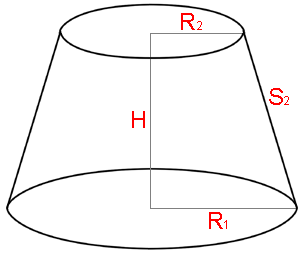
With these numbers, you can calculate your T angle and your S1 and S2 lengths buy using the following formulas or this Cone/Frustum Windscreen Potstand Calculator.
R1 = Base Diameter / 2
R2 = Top Diameter / 2
S1 = R1 / ((R1-R2) / sqrt(H2 + [R1-R2]2)) = R2 x S2 / (R1 - R2) + S2
S2 = S1 - R2 / ((R1-R2) / sqrt(H2 + [R1-R2]2)) = sqrt(H2 + (R1-R2)2)T = 360 x ((R1-R2) / sqrt(H2 + [R1-R2]2)) = 360 x (R1 - R2) / S2
Top Diameter:
Base Diameter:
Cone Height:
Stove Height: Space between Pot and Stove:
End Overlap (see chart): Fiddle Factor:
S1: S2: S1-S2: T Angle: Support Height (from base):
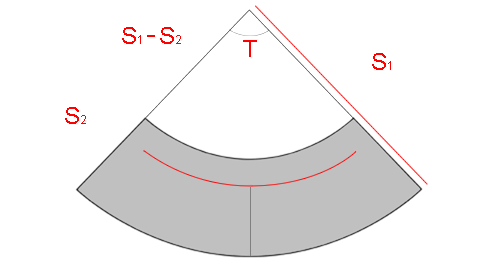
Add to Top and Base lengths for overlap.
Wall Slope: º
Other Slope: º
Use a piece of paper to draw out the shape of your cone and remember to add a little to the ends to allow for overlapping. You can use a string, ruler, length of coat hanger with loops on each end (for pen and pivot nail), etc to measure out the S1 and (S1 - S2) lengths. Use your chosen measuring device to measure out the two arcs by pivoting them on the apex of the T angle. Cut the paper sheet to size and see if it comes together and creates your desired shape. If not, make your adjustments or start over with new measurements.
Once you are happy with your shape, you can use your paper trial as a template to cut out your actual pot stand.
Captain Paranoia PS Cone Templates
Captain Paranoia in the UK has created a very sophisticated PostScript code which will create a printable paper template for a cone shaped windscreen, potstand or other conical project. It contains several adjustable variables described in the supporting instruction files which will allow you to adjust for various sized cones.
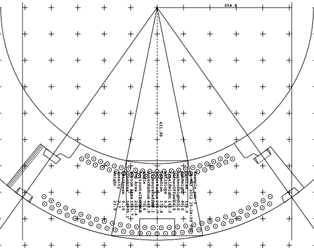
Draughtsman's construction method preview of template
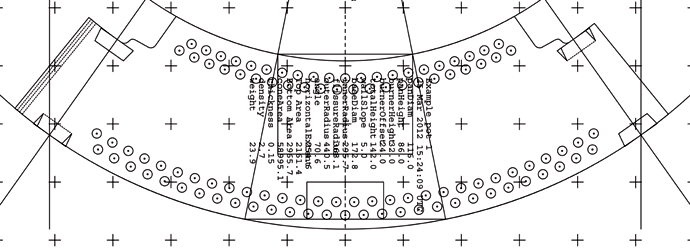
Sample Conic Windscreen Template
Note special joint ends, provision for handles and scale view of pot, stove and sidewalls in center
This tool has GREAT utility for any number of cone shaped projects which you may consider. It is important to note that this tool can be used to make templates for the windscreens, stoves and potstands described in US Patents 6,520,173. 7,107,983 and 7,967,003 B2 . These patents are owned by the fine folks at Stratus, Tipi Stoves and Trail Designs who produce and sell the "TrailStove", "Tipi Lite" and "Caldera Cone", respectively. In the US, it is unlawful to make and use an item under active US patent protection for anything other than experimental use without explicit permission from the patent owner. Doing so places you at risk of a civil suit. That said, this tool still has great potential and can help with many windscreen and pot stand designs. You can replicate potstand designs which were patented greater than 20 years ago, create ones which are completely unique (that do not infringe on active patents), or experiment with designs under active patent protection. If you are in the US and would like to have a potstand or stove which is under protection of an active US patent, you can contact the owner of that patent. They will likely be more than happy to provide you with one for a reasonable price or even grant permission for you to build your own unique one if you ask nicely. If you are outside the US, you are likely able to do whatever you like with the many designs presented on this page; please review your own local laws and patents prior to proceeding.
Please review the Conical Shaped Potstand Patent section above prior to any project. This section lists some of the potential Non-Patent Infringement Projects you can use this tool for.
NOTE: The tool presented here is shared with the understanding that it is intended for NONCOMMERCIAL USE ONLY.
Use of this tool for commercial purposes is prohibited.
Captain Paranoia's Files and related Link:
US Instruction File - US version of instructions on use of PS file.
UK Instruction File - UK version of instructions on use of PS file.
outdoorsmagic.com 22357 - Forum Thread about this tool. History, discussion and examples
PostScript viewers:
GhostScript, GSView - open source viewer
view.samurajdata.se - online viewer
PhotoShop - views Draughtsman's page only
Adobe Distiller
|
Here is Captain Paranoia's PostScript Tool below. To use, simply:
|
|
||||||||||||||||||||||||||||||||||||||||||||||||||||||||||||||||||||||||||||||||||||||||||||||||||||||||||||||||||||||||||||||||||||||||||||||||||||||||||||||||||||||||||||||||||||||||||||||||||||||||||||||||
Potentially Useful Calculators:
|
||||||||||||||||||||||
|
||||||||||||||||||||
|
||||||||||||||||
A simpler version of this template is also found at outdoorsmagic.com 22357. Copy and paste this scripting code into a text file and save it as something like Cone.PS
Adjust the follow parameters for your setup:
Pan diameter - increase this number if you would like space between your pot and potstand for ventilation
Pan height
Burner height - stove height if used
Burner flame offset - space between stove and bottom of pot
Handle width
Handle depth
Number of holes at bottom
Number of holes at top
Size of holes
Scale to fit A3 (0/1)
Split into two pages (0/1)
Use GhostScript, GSView, view.samurajdata.se, Postscript Viewer, PhotoShop or Adobe Distiller to open and print.
You should get something like (but larger):
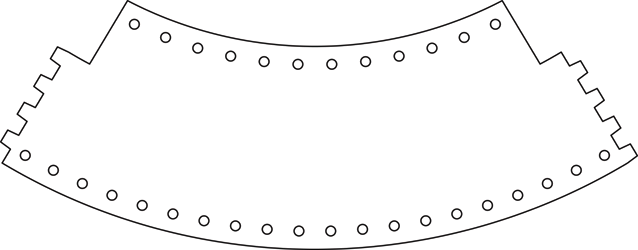
Other Cone Potstand Instructions
Several other instructions of various variations for building a cone shaped windscreen are available on the web. Some of these are far more user friendly to follow than the one I presented above. Note that most of these are instructions on how to clone a US patented windscreen sold by Trail Designs. Please review the laws of your country and do what you feel is morally and legally correct. In most of the world (except the US), you can make whatever potstand you like for personal use. In the US, you are allowed to experiment with patented inventions. This allows you to legally trial various potstand designs and even improve upon their designs. This provision, however, does not protect you from experimental marketing and sales of a clone.
zdnet.co.uk cone-layout-39187274
Other Conical Potstand and related Links:
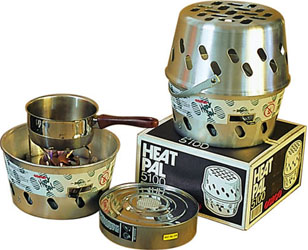
Origo Heat Pal 5100
trailstove.com Archived from 2000
Noflie mark 11 biomass stove
Sibley Tent Stove
YouTube JJLHsUAhyrM Firemug/Holey Grail Stoves.... "The Rock" Stove
YouTube 5qS feeCOm4 "HOLEY GRAIL" Woodstove bplite.com 4684
backpackinglight.com 503039 Elevated stove, conical windscreen concept
ultraknilch.blogspot.com der-perfekte-topf
Engineering Design Project 2 Sustainable Cooking for the Developing World
Origo Heat Pal 5100
Other US Patents:
Publication 2006/0243271 A1
US 2005/0011877 A1
178,755 - conical potstand supports kettle from bottom with special protrusion under pot. Also a water heater.
184,303 - inverted cone over kero lamp
184,148 - conical "air-jacket" with vented top
229,450 - soldered/brazed cone support
231,025 - inverted cone potstand with L shaped groove and nub to lock pot to potstand
773,744 - firepot
835,693 - Hourglass shaped potstand
879,539 - conical potstand which allows for adjustable heat and heating of irons
915,239 - 1908 collapsible sheet metal stove
36,584 - Heater for Lamp Chimneys
136,521 - Improvement in Portable Stoves
673,965 -
1,278,988 - adjustable size conical heat shield
1,321,318 - Conical sides around pot which allow for toasting of bread
1,375,028 - Steamer shows conical bottom and cylinder top stacked
1,413,012 - coffee pot with cone shaped bottom section and pot shaped top section
1,648,725 - Top of cone has a ventilated inner downward facing cone section to grab pot - similar to Strata
1,999,886 - riveted on tabs for support
2,431,193 - cone shaped support attached to kettle or pot
3,978,844 pan or kettle with integral cone shaped stand, stove and gas canister in handle. See cited ref and referenced by patents
5,417,200 - Lantern Cooker
5,651,356 - portable heater
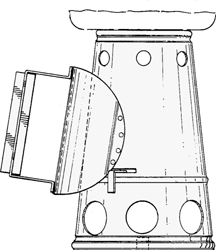
1984 US Patent 4,604,986 and D288843
Cone shaped design concentrates heat under pot
Handle on left makes it easy to move a hot stand
Can be used as a potstand and/or as a charcoal starter
Nothing compares to a well grilled or barbequed piece of meat. And with a huge market for charcoal technology, a lot of effort has been put into making charcoal use easier and better. Much of the research and ideas surrounding this technology can be used in you pot stand designs.
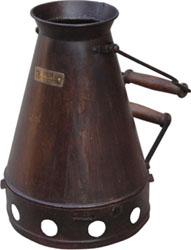
Kadai Charcoal Starter
Charcoal Starters (related technology and ideas):
2,920,614 - rectangular can be used upright or on side
3,159,119 - Zip Stove
3,191,556 - with fan like Zip Stove